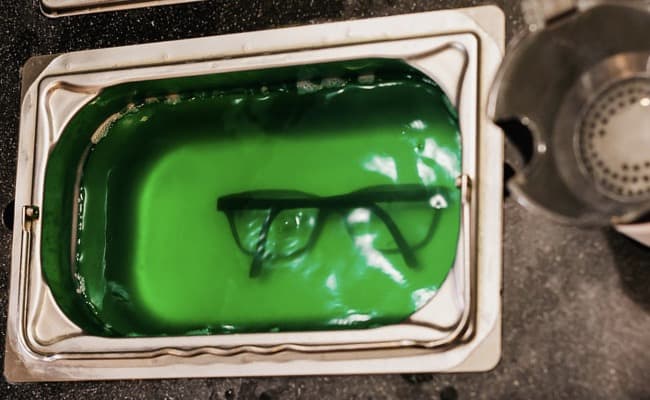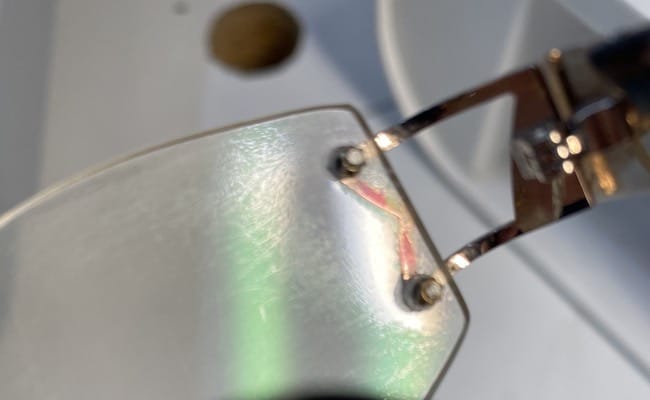The effect of ultrasonic cleaner causes dirt residues from the glasses to be blown off the parts in the liquid, including from recesses and even from holes.
Ultrasonic cleaner only needs a few seconds and surpasses any manual cleaning in effectiveness. At the same time, ultrasonic cleaners are gentle because mechanical damage such as scratches is avoided.
However, if the coating on your lenses is already defective, the ultrasonic bath could cause the coating to peel off more quickly. Likewise, certain natural materials such as wood, horn, or frames with rhinestones should not be cleaned in an ultrasonic bath, as they could be quickly damaged by the ultrasound.
In addition, handling errors often occur when using ultrasonic baths, which could damage the eyeglass bath or the eyeglasses. The most common handling errors damaging eyeglasses with an ultrasonic cleaner are:
- No basket is used in the ultrasonic cleaner
- The additional cleaning liquid is too aggressive for the glasses coating
- The frequency of the ultrasonic bath is lower as 35kHz
- Hot water is used in the ultrasonic bath
- More or less than the recommended amount of water is used

The Frequency Is Not Ideal Under 35khz
The cleaning of glasses works with ultrasonic baths because little oscillations of the water in the bath are generated. During the tension phase, these oscillations lead to the generation of millions of tiny vacuum bubbles in all fluids, which implode during the compression phase, generating highly effective pressure surges.
When the frequency falls below 35kHz those pressure surges can lead to mechanical strain that could damage glasses.
For this purpose, the device components must be optimized and tuned so that they always generate the best operating frequency, even with changing loads due to load, level, temperature, and liquid. During operation, the working frequency can deviate considerably from the nominal frequency due to slight frequency modulation.
Rigid operating frequencies in ultrasonic devices can lead to standing waves in the ultrasonic bath under unfavorable conditions.
Standing waves create inhomogeneous sonication and, in the worst case, can damage sensitive cleaning objects. The targeted, very fast frequency changes of the frequency modulation automatic frequency control generate a particularly homogeneous, uniform ultrasonic field in the entire bath volume. This frequency modulation in ultrasonic baths is often described as sweep tec.
Generally speaking, 35kHz is recommended to clean glasses effectively and without damage. But what if the damage is already within the glasses when you bought it?
Where People See Damages First on the Glasses After Using Ultrasonic Cleaners?
When people see the damages on the glasses usually it is the coating. The coating had to undergo mechanical strain as a CNC machine cut the shape of the lenses out of a round bigger lens. This cutting process produced heat where around the edges of the lenses.
Of course, a cooling liquid is always used but on a microscopic level, the coating will be influenced. So this is where people see the damages first. The coating starts to peel off from the edges and the damage over time works its way into the middle of the lenses.

Even worse is the situation when the glasses are rimless. With this type of glasses, the coating has to undergo additional mechanical strain as holes get drilled and the components will cause slight pulling and pressure movements when the glasses are used which causes microscopic cracks in the coating.
When the ultrasonic cleaner is used the imploding vacuum bubbles will then rip off the coating in the areas where damages are already present. Here in the picture above you can see typical damages. The coating peeled off where the frame is mounted to the lenses on rimless eyewear.
When the Additional Cleaning Liquid Is Too Aggressive for the Glasses Coating
A lot of people make the mistake of using cleaning compounds where alcohol is in or other aggressive components in combination with the ultrasonic bath. This habit will add additional chemical stress to the coating and will damage the coatings faster.
You should avoid aggressive cleaners generally. With most glasses, you will be fine using dishwashing liquid which will make it easier to clean the grease on your glasses. Do not make the mistake of buying a sensitive option of the dishing liquid as this will produce smear on the lenses which need to be polished with the microfiber cloth.
Hot Water Is Used In the Ultrasonic Cleaner
As described in the upper part of this article the components of the ultrasonic baths are fine-tuned to a certain temperature and a fluid level. Generally speaking when you use hot water the coating will expand at a different rate compared to the underlying material of the lenses which causes microfractures.
Never use hot water to clean your glasses. You should also avoid using the ultrasonic cleaners without the basket as the position of the glasses directly on the floor of the bath could lead to unfavorable mechanical stress that could damage not only your glasses but also your ultrasonic cleaner.
Do You Have a Really Thin Lens Material?
With the information above you now know the coating of your lenses might have tiny cracks right from the get-go which increases the likelihood of your coatings getting peeled off over time. When you have really thin plastic lenses especially the 1.74 materials are more prone to damaged coatings. If you are using classic glass lenses your coating and the surfaces of the lenses will be far more durable and you will probably never have to deal with a peeled-off coating.
Do Not Use an Ultrasonic Cleaner in Combination With Those Materials
- Wood
- Stone
- Paper
- Buffalo horn
- TR90 coated derivates of it
All of the upper parts of the article were focused on the damage of the lenses the ultrasonic bath could make worse. But of course, the frames also could be damaged especially when the frames are made out of natural materials like wood. When you put a wooden frame into an ultrasonic bath the wood fibers will oftentimes loosen up a little and the fluid can soak into the material. Never use ultra-sonic cleaners with natural materials.
But at the end of my list, I also mentioned a plastic material where we saw damages too in combinations with ultrasonic cleaners. Here in the picture above, you can see how the coating peels off and the surface roughens up a little.
So before you decide to buy an ultrasonic cleaner make sure to ask your optician if your glasses can undergo this cleaning process. Personally, as an optician, I am a huge fan of ultrasonic cleaners and in our workshop, we use them daily. However, we only use them for a couple of seconds. We hold them, in turn, the bath on and you can see the grease and dirt removed in the fluid. The glasses should not undergo this cleaning process for minutes or even more.
Conclusion
When you bought glasses with plastic lenses the coating will slowly degrade over time. Your surfaces of the lenses and of the frame undergo mechanical and thermal strain in the time you wear them. An ultrasonic cleaner is a safe way to clean and when used correctly it is a good way. But as you saw there are many pitfalls when the ultrasonic cleaner indeed causes damage to your glasses.
As an optician, I know the materials and I personally use the ultrasonic bath every day with my lenses and never had issues. But I have also seen a couple of customers over the years that used an ultrasonic cleaner and reported severe damage. In most cases, the coating or the surface was already damaged and the cleaning may be led to a faster damaging process. But so would rubbing your lenses with a microfibre cloth. Buy a good ultrasonic bath to avoid damage to your glasses.
I wish you a great day.
